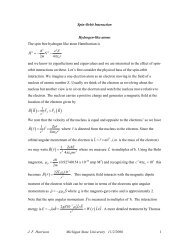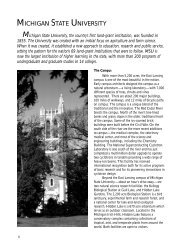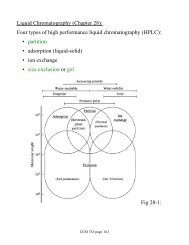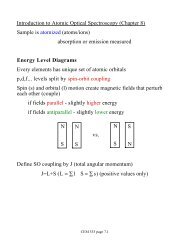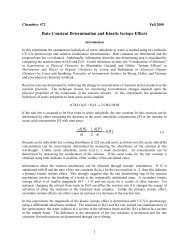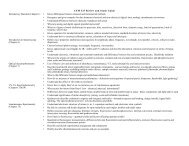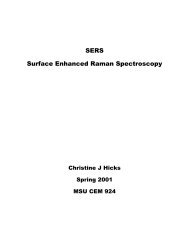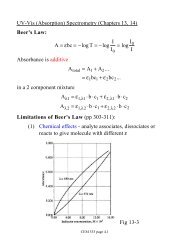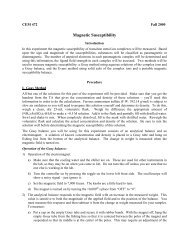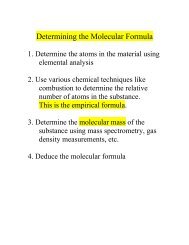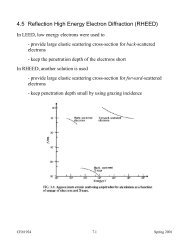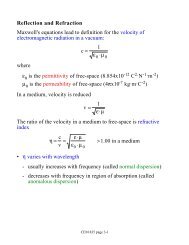chapter 5 - Department of Chemistry
chapter 5 - Department of Chemistry
chapter 5 - Department of Chemistry
Create successful ePaper yourself
Turn your PDF publications into a flip-book with our unique Google optimized e-Paper software.
The Mosaic browser, developed in 1993 by a student, MarcAndreessen, and Eric Bina <strong>of</strong> the National Center for SupercomputingApplications, “did more than any other developmentto bring about the phenomenal growth <strong>of</strong> the Web andthe Internet” [TCAW, 1995, 4(4)]. There were only 100 Websites in 1992, but hundreds <strong>of</strong> thousands by the end <strong>of</strong> thedecade. With the development <strong>of</strong> the Internet came “[a] newtrend: using the Internet to provide information and supportfor products and services” [TCAW, 1995, 4(4)]. Some examples<strong>of</strong> the enhanced use <strong>of</strong> the Web were the arrival <strong>of</strong> AmericanChemical Society (ACS) journals online and the ASAP (AsSoon As Publishable) publishing system for rapid release <strong>of</strong>articles, the availability <strong>of</strong> Pittcon ‘97 Web sites, and, in 1998,the ACS presentation <strong>of</strong> “Pittcon Live” on the Internet.Environmental FluxAt first, even the environmental movement seemed to haveslowed, despite the celebrations <strong>of</strong> the 20th anniversary,Earth Day and the comments <strong>of</strong> Jim Byrne, president <strong>of</strong>Centcom, who announced at the 1990 Pittcon that “environmentalanalysis [was] undoubtedly one <strong>of</strong> the most significantgrowth areas for analytical instruments” [Today’sChemist, 1990, 3(4)]. Part <strong>of</strong> the problem was a backlashagainst what was seen as environmental excess. Articles inToday’s Chemist at Work emphasized what the writers saw asoverreaction to the dangers <strong>of</strong> chlorinated compounds,global warming, pesticides, dioxins, lead, and other environmental“risks.” In 1990, Patrick P. McCurdy, then editor<strong>of</strong> Today’s Chemist at Work, said, “Some scientists even seegood in global warming.” Contributing editor Ken Reese remarked,“Bashing lead, in fact, quite apart from the merits<strong>of</strong> specific cases, has become politically correct” [TCAW1995, 4(3)].Antiregulatory-versus-environmentalist battles grew evermore heated. “Everything in life is full <strong>of</strong> one-in-a-hundredrisks. If the EPA [U.S. Environmental Protection Agency] isspending all its time trying to protect the public againstone-in-a-million hypothetical risks, then it’s spending itstime on trivia,” A. B. Nichols said [TCAW, 1992, 1(4)]. Congressionalbacklash in 1995 led to Republican moves toslice the EPA budget 34% and attempts to provide industryimmunity to certain Superfund liability provisions.One key triumph was overturning what had been seen asonerous overregulation. The hated Delaney clause was replacedin 1996 with far less restrictive requirements than“zero tolerance.”The 1995 Nobel Prize in <strong>Chemistry</strong>, awarded to PaulCrutzen, Mario Molina, and F. Sherwood Rowland, whobroke the news on ozone depletion, was seen by most as avindication <strong>of</strong> their work. Still, antienvironmentalists complained“that the ozone depletion theory is based on badscience” and that the award was “a desecration upon theheritage <strong>of</strong> Alfred Nobel” [TCAW 1996, 5(10)].On the whole, the public did not appreciate attempts tocounter regulations, nor did they share in the view <strong>of</strong> a putuponindustry. Opinion polls conducted by the Chemical ManufacturersAssociation (CMA) in 1990 found that “there [was] alack <strong>of</strong> trust in chemical manufacturers on the part <strong>of</strong> the public;indeed, people [did] not like the chemical industry as awhole” [Today’s Chemist, 1990, 3(2)]. And even though the author<strong>of</strong> a February 1992 Money magazine poll claimed thatchemists had “excellent” prestige, according to Today’s Chemistat Work, this label did not apply to the industry in which theyworked [TCAW, 1992, 1(4)]. As seen by the early CMA poll, theissues <strong>of</strong> antiscience and antichemical industry grew in importance.Polls taken in the latter part <strong>of</strong> the decade still showedthat a favorable opinion toward the chemical industry wasbarely higher than 20%, despite the efforts <strong>of</strong> the ResponsibleCare program, inaugurated in the 1980s.In 1992, promoting the spirit <strong>of</strong> voluntary self-regulation,the CMA adopted the Product Stewardship Code as part <strong>of</strong> ResponsibleCare and imposed a deadline for member adoption.The Green <strong>Chemistry</strong> program was another attempt at environmentallybenign and consumer-friendly manufacturing.In 1995, the Presidential Green <strong>Chemistry</strong> Challenge Awardswere established to reward companies that had managed tomake the transition to “green” manufacturing practices. InEurope, throughout the 1990s, HP spent nearly $1 million ayear on the popular Rhine Basin Program, which by 1997 hadexpanded to include environmental monitoring <strong>of</strong> 15 otherrivers and was expanding its partnership with various Europeanauthorities.As a result <strong>of</strong> this new wave <strong>of</strong> environmental and healthgive-and-take between industry and the general public, riskand risk assessment became hot topics. To deal with this issue,in 1995 Chemical & Engineering News sponsored a symposiumentitled “Risk Issues and the Chemical Industry: TheSummit on Risk-Based Public Policy.”90 Made to Measure March 1999 http://pubs.acs.org



